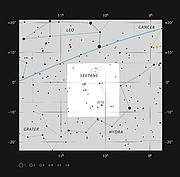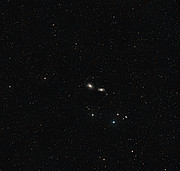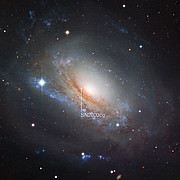Pressmeddelande
Störda galaxer bildar ett märkligt par
20 april 2011
Galaxerna i detta kosmiska par, här fångade med kameran WFI på 2,2 meters MPG/ESO-teleskopet vid La Silla-observatoriet i Chile, uppvisar en del underliga drag. De ligger så nära varandra att de förvrids av den inbördes tyngdkraftens verkningar. Den gravitationella dragkampen galaxerna emellan har förvrängt spiralformen i den ena galaxen, NGC 3169, och dragit isär stoftstråk i dess följeslagare NGC 3166. Samtidigt sitter en tredje, mindre galax – nedan till höger i bilden – på första parkett för att bevittna hur dessa krafter vrider och drar i dess större grannar.
Galaxgruppen, som ligger omkring 70 miljoner ljusår bort i stjärnbilden Sextanten, upptäcktes 1783 av den engelske astronomen William Herschel. Enligt dagens astronomer är avståndet mellan NGC 3169 (till vänster) och NGC 3166 (till höger) bara 50 000 ljusår. Separationen motsvarar bara ungefär hälften av vår egen galax Vintergatans diameter. Trängseln gör att tyngdkraften på allvar kan börja rubba galaxernas struktur.
Spiralgalaxer som NGC 3169 och NGC 3166 brukar visa upp välordnat virvlar av stjärnor och stoft som snurrar runt deras lysande centrum. Men närkontakt med andra tunga himlakroppar kan rubba denna klassiska konfiguration, och detta som ett förespel till att galaxerna faller samman och bildar en enda, större galax. Än så länge har växelverkan mellan NGC 3169 och NGC 3166 bara skänkt karaktär åt deltagarna i dramat. NGC 3169:s armar, starkt lysande tack vare dess stora, unga, blåa stjärnor, har tvingats isär, och mängder av lysande gas har dragits ut ur galaxens skiva. I NGC 3166 är det istället stoftstråken, som normalt brukar avgränsa spiralarmarna, som fallit i oreda. Till skillnad från situationen i dess blåare granne bildas få nya stjärnor i NGC 3166.
NGC 3169 har ännu ett kännetecken i den svaga gula punkten som strålar genom en slöja av stoft strax till vänster om och nära galaxens mitt [1]. Denna blixt är resterna efter en supernova som upptäcktes 2003 och som då fick beteckningen SN 2003cg. En supernova Typ Ia som detta är frågan om, tros uppstå när en så kallad vit dvärg – en stjärna som är den täta och heta resten efter en mellanstor stjärna som solen – på gravitationell väg drar bort gas från en närliggande stjärnkompanjon. Tillskottet av bränsle sätter så småningom igång en okontrollerad fusionsreaktion som spränger stjärnan.
Den nya bilden av denna märkliga och dynamiska galaxduo är skapad av data som valdes ut av Igor Chekalin för ESO:s astrofotografitävling Hidden Treasures 2010. Chekalin vann tävlingens första pris och just denna bild kom på andraplats av de nästan 100 tävlingsbidragen [2].
Noter
[1] Andra mer påfallande ljuspunkter på bilden – som till exempel den vid den vänstra änden av NGC 3169:s undre spiralarm – är stjärnor inuti Vintergatan som av en slump råkar ligger i siktlinjen mellan våra teleskop och dessa galaxer.
[2] Tävlingen ESO:s Hidden Treasures 2010 gav amatörastrononer tillfälle att söka genom ESO:s jättearkiv med astronomiska data för att försöka hitta en väl gömd pärla som kunde poleras upp av tävlingsdeltagarna. Mer om Hidden Treasures kan du läsa på tävlingens hemsida.
Mer information
ESO, Europeiska sydobservatoriet, är Europas främsta samarbetsorgan för astronomisk forskning och världens mest produktiva astronomiska observatorium. Det stöds av 15 länder: Belgien, Brasilien, Danmark, Finland, Frankrike, Italien, Nederländerna, Portugal, Schweiz, Spanien, Storbritannien, Sverige, Tjeckien, Tyskland och Österrike. ESO:s ambitiösa verksamhet rör design, konstruktion och drift av avancerade markbaserade forskningsanläggningar som gör det möjligt för astronomer att göra banbrytande vetenskapliga upptäckter. ESO spelar dessutom en ledande roll i att främja och organisera samarbeten inom astronomisk forskning. ESO driver tre unika observationsplatser i Chile: La Silla, Paranal och Chajnantor. Vid Paranal finns Very Large Telescope, världens mest avancerade observatorium för synligt ljus, och VISTA, det största kartläggningsteleskopet. ESO bidrar dessutom till ALMA, ett revolutionerande astronomiskt teleskop och världens hittills största astronomiska projekt. ESO planerar för närvarande bygget av ett 42-meters europeiskt extremt stort teleskop för synligt och infrarött ljus, E-ELT, som kommer att bli ”världens största öga mot himlen”.
Kontakter
Richard Hook
ESO, La Silla, Paranal, E-ELT and Survey Telescopes Public Information Officer
Garching bei München, Germany
Tel: +49 89 3200 6655
Mobil: +49 151 1537 3591
E-post: rhook@eso.org
Johan Warell (Presskontakt för Sverige)
ESO:s nätverk för vetenskaplig kommunikation
Skurup, Sverige
Tel: +46-706-494731
E-post: eson-sweden@eso.org
Om pressmeddelandet
| Pressmeddelande nr: | eso1114sv |
| Namn: | NGC 3165, NGC 3169 |
| Typ: | Local Universe : Galaxy : Type : Interacting |
| Facility: | MPG/ESO 2.2-metre telescope |
| Instruments: | WFI |
Our use of Cookies
We use cookies that are essential for accessing our websites and using our services. We also use cookies to analyse, measure and improve our websites’ performance, to enable content sharing via social media and to display media content hosted on third-party platforms.
ESO Cookies Policy
The European Organisation for Astronomical Research in the Southern Hemisphere (ESO) is the pre-eminent intergovernmental science and technology organisation in astronomy. It carries out an ambitious programme focused on the design, construction and operation of powerful ground-based observing facilities for astronomy.
This Cookies Policy is intended to provide clarity by outlining the cookies used on the ESO public websites, their functions, the options you have for controlling them, and the ways you can contact us for additional details.
What are cookies?
Cookies are small pieces of data stored on your device by websites you visit. They serve various purposes, such as remembering login credentials and preferences and enhance your browsing experience.
Categories of cookies we use
Essential cookies (always active): These cookies are strictly necessary for the proper functioning of our website. Without these cookies, the website cannot operate correctly, and certain services, such as logging in or accessing secure areas, may not be available; because they are essential for the website’s operation, they cannot be disabled.
Functional Cookies: These cookies enhance your browsing experience by enabling additional features and personalization, such as remembering your preferences and settings. While not strictly necessary for the website to function, they improve usability and convenience; these cookies are only placed if you provide your consent.
Analytics cookies: These cookies collect information about how visitors interact with our website, such as which pages are visited most often and how users navigate the site. This data helps us improve website performance, optimize content, and enhance the user experience; these cookies are only placed if you provide your consent. We use the following analytics cookies.
Matomo Cookies:
This website uses Matomo (formerly Piwik), an open source software which enables the statistical analysis of website visits. Matomo uses cookies (text files) which are saved on your computer and which allow us to analyze how you use our website. The website user information generated by the cookies will only be saved on the servers of our IT Department. We use this information to analyze www.eso.org visits and to prepare reports on website activities. These data will not be disclosed to third parties.
On behalf of ESO, Matomo will use this information for the purpose of evaluating your use of the website, compiling reports on website activity and providing other services relating to website activity and internet usage.
Matomo cookies settings:
Additional Third-party cookies on ESO websites: some of our pages display content from external providers, e.g. YouTube.
Such third-party services are outside of ESO control and may, at any time, change their terms of service, use of cookies, etc.
YouTube: Some videos on the ESO website are embedded from ESO’s official YouTube channel. We have enabled YouTube’s privacy-enhanced mode, meaning that no cookies are set unless the user actively clicks on the video to play it. Additionally, in this mode, YouTube does not store any personally identifiable cookie data for embedded video playbacks. For more details, please refer to YouTube’s embedding videos information page.
Cookies can also be classified based on the following elements.
Regarding the domain, there are:
- First-party cookies, set by the website you are currently visiting. They are stored by the same domain that you are browsing and are used to enhance your experience on that site;
- Third-party cookies, set by a domain other than the one you are currently visiting.
As for their duration, cookies can be:
- Browser-session cookies, which are deleted when the user closes the browser;
- Stored cookies, which stay on the user's device for a predetermined period of time.
How to manage cookies
Cookie settings: You can modify your cookie choices for the ESO webpages at any time by clicking on the link Cookie settings at the bottom of any page.
In your browser: If you wish to delete cookies or instruct your browser to delete or block cookies by default, please visit the help pages of your browser:
Please be aware that if you delete or decline cookies, certain functionalities of our website may be not be available and your browsing experience may be affected.
You can set most browsers to prevent any cookies being placed on your device, but you may then have to manually adjust some preferences every time you visit a site/page. And some services and functionalities may not work properly at all (e.g. profile logging-in, shop check out).
Updates to the ESO Cookies Policy
The ESO Cookies Policy may be subject to future updates, which will be made available on this page.
Additional information
For any queries related to cookies, please contact: pdprATesoDOTorg.
As ESO public webpages are managed by our Department of Communication, your questions will be dealt with the support of the said Department.





